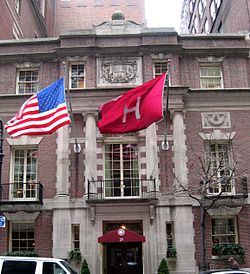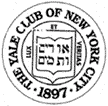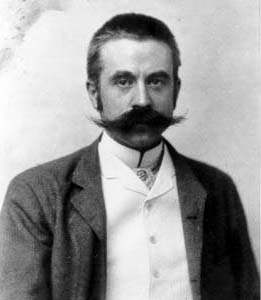
Stanford White was an American architect. He was also a partner in the architectural firm McKim, Mead & White, one of the most significant Beaux-Arts firms. He designed many houses for the rich, in addition to numerous civic, institutional, and religious buildings. His temporary Washington Square Arch was so popular that he was commissioned to design a permanent one. His design principles embodied the "American Renaissance".

Charles Follen McKim was an American Beaux-Arts architect of the late 19th century. Along with William Rutherford Mead and Stanford White, he provided the architectural expertise as a member of the partnership McKim, Mead & White.

William Rutherford Mead was an American architect who was the "Center of the Office" of McKim, Mead, and White, a noted Gilded Age architectural firm. The firm's other founding partners were Charles Follen McKim (1847–1909), and Stanford White (1853–1906).

The Racquet and Tennis Club, familiarly known as the R&T, is a private social and athletic club at 370 Park Avenue, between East 52nd and 53rd Streets in Midtown Manhattan, New York City.

Tiger Inn is one of the eleven active eating clubs at Princeton University in Princeton, New Jersey. Tiger Inn was founded in 1890 and is one of the "Big Four" eating clubs at Princeton, the four oldest and most prestigious on campus. Tiger Inn is the third oldest Princeton Eating Club. Its historic clubhouse is located at 48 Prospect Avenue, Princeton, New Jersey, near the Princeton University campus. Members of "T.I." also frequently refer to the club as "The Glorious Tiger Inn."

McKim, Mead & White was an American architectural firm that came to define architectural practice, urbanism, and the ideals of the American Renaissance in fin de siècle New York. The firm's founding partners Charles Follen McKim (1847–1909), William Rutherford Mead (1846–1928) and Stanford White (1853–1906) were giants in the architecture of their time, and remain important as innovators and leaders in the development of modern architecture worldwide. They formed a school of classically trained, technologically skilled designers who practiced well into the mid-twentieth century. According to Robert A. M. Stern, only Frank Lloyd Wright was more important to the identity and character of modern American architecture.

The Colony Club is a women-only private social club in New York City. Founded in 1903 by Florence Jaffray Harriman, wife of J. Borden Harriman, as the first social club established in New York City by and for women, it was modeled on similar gentlemen's clubs. Today, men are admitted as guests.

The University Club of New York is a private social club at 1 West 54th Street and Fifth Avenue in the Midtown Manhattan neighborhood of New York City. Founded to celebrate the union of social duty and intellectual life, the club was chartered in 1865 for the "promotion of literature and art". The club is not affiliated with any other University Club or college alumni clubs. The club is considered one of the most prestigious in New York City.

The University Cottage Club or simply Cottage Club is one of eleven current eating clubs at Princeton University, in Princeton, New Jersey, United States. It is one of the six bicker clubs, along with The Ivy Club, Tiger Inn, Cap and Gown Club, Cannon Club and Tower Club.
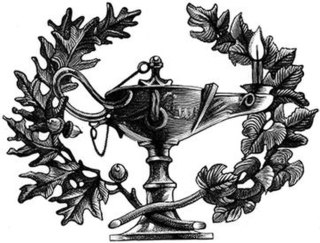
The Century Association is a private social, arts, and dining club in New York City, founded in 1847. Its clubhouse is located at 7 West 43rd Street near Fifth Avenue in Midtown Manhattan. It is primarily a club for men and women with distinction in literature or the arts. The Century Association was founded by members of New York's Sketch Club; preceding clubs also included the National Academy of Design, the Bread and Cheese Club, and the Column. Traditionally a men's club, women first became active in club life in the early 1900s; the organization began admitting women as members in 1988.

The Algonquin Club of Boston, presently known as The Quin House, is a private social club in Boston, Massachusetts, founded in 1886. Originally a business-themed gentlemen's club, it is now open to men and women of all races, religions, and nationalities.

The Harvard Club of Boston is a private social club located in Boston, Massachusetts. Its membership is open to alumni and associates of Harvard University, Massachusetts Institute of Technology, Yale University, and Fletcher School of Law and Diplomacy at Tufts University. The Back Bay Clubhouse is located in Boston's historic Back Bay neighborhood, at 374 Commonwealth Avenue.

The Bowdoin College Museum of Art is an art museum located in Brunswick, Maine. Included on the National Register of Historic Places, the museum is located in a building on the campus of Bowdoin College designed by the architectural firm McKim, Mead, and White.
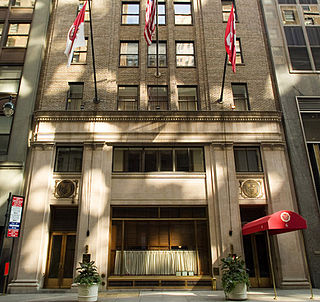
The Cornell Club of New York, usually referred to as The Cornell Club, is a private club in Midtown Manhattan, New York City. Its membership is restricted to alumni and faculty of Cornell University, family of Cornellians, business associates of Members, and graduates of The Club's affiliate schools.
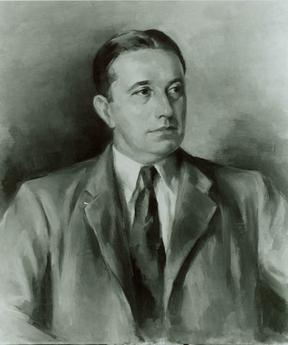
James Kellum Smith was an American architect, of the Gilded Age architectural firm of McKim, Mead, and White.
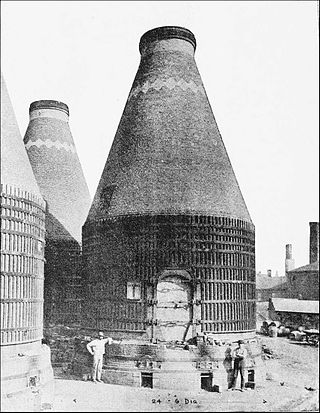
Perth Amboy Terra Cotta Company of Perth Amboy, New Jersey, was a late-nineteenth- and early twentieth-century brickworks, known for the manufacture of many prominent and unique architectural terracotta elements.

The Columbia University Club of New York is a private university alumni club that extends membership to all graduates of all the schools and affiliates of Columbia University, as well as Columbia undergraduate students, graduate students, faculty and administrators. The Club has more than 2,500 Columbia members representing all the schools and affiliates of Columbia University.
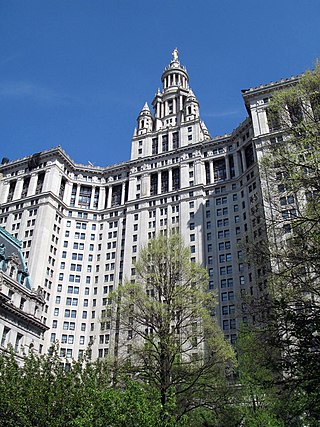
William Mitchell Kendall was an American architect who spent his career with the New York firm of McKim, Mead & White, the leading American architectural practice at the turn of the century, renowned for its classical work. Kendall joined the firm in 1882, became a partner in 1906, and remained with the firm until his death in 1941. He was closely associated at the firm with partner Charles Follen McKim until McKim's death in 1909, and added a refined delicacy to McKim’s somewhat severe Roman classicism.
